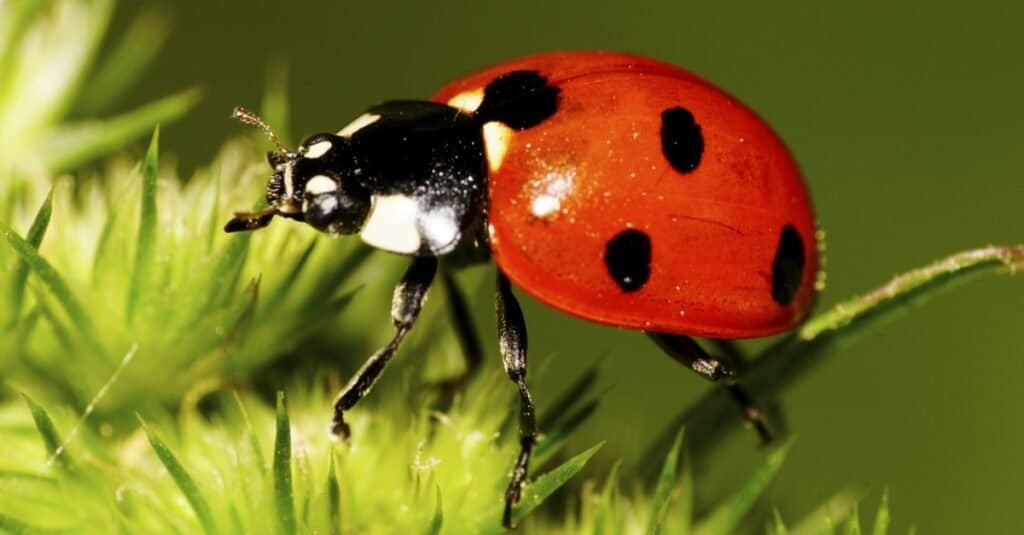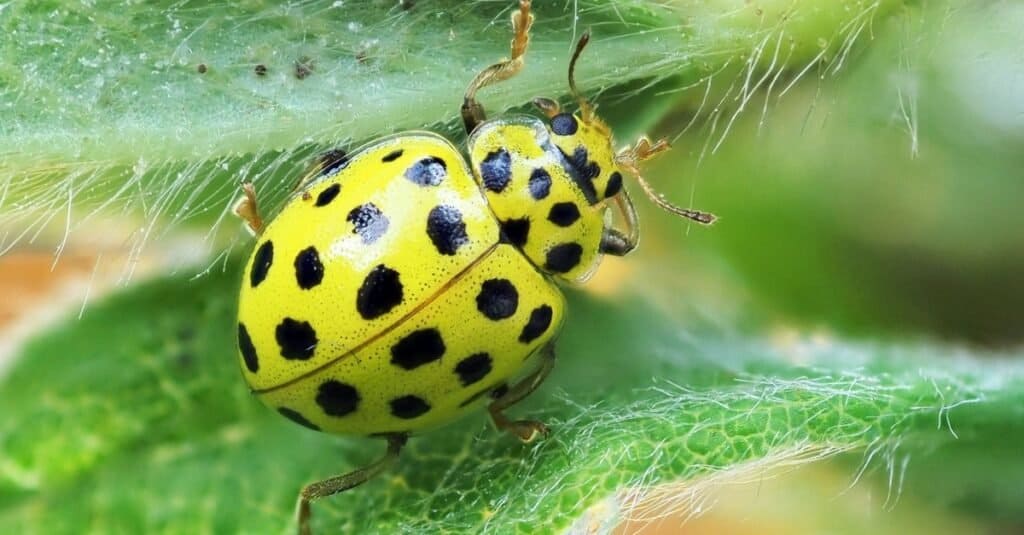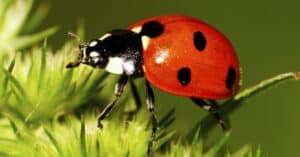Ladybugs are tiny little bugs that typically live between 1-2 years. Ladybugs are also known as ladybeetles and ladybird beetles. They are bright red, with black spots. There are over 5,000 species of ladybugs worldwide, but the one most people recognize is native to North America and represents good luck.
Since they live in such diverse places, you can imagine they experience cold winters. So, where do ladybugs go in the winter? How do they survive? Keep reading to learn more about the unique life of this lucky insect.
Where Do Ladybugs Live?

Ladybugs live just about anywhere, but the exact location depends on their activity and species.
© Sergey/Shutterstock.com
Before we dive into how ladybugs survive winter, it’s a good idea to learn more about these interesting insects. Ladybugs live just about anywhere, but the exact location depends on their activity and species. For example, some ladybugs live in shelters, hidden from the outside, during winter. However, winter doesn’t look the same everywhere. Follow along down below to discover where common species of ladybugs live and more fun facts about them.
Seven-Spot Ladybug
Seven-spot ladybugs are among the most common species in North America, and they also live in Europe. These bugs live in many different environments as long as a healthy population of aphids is nearby. This is why you might see more ladybugs in your garden. They are beneficial and eat the aphids that ruin common plants. Apart from insects, seven-spot ladybugs also consume nectar and pollen. Although not native to the United States, there are many residing in the country. You can also find seven-spot ladybugs in Russia, Siberia, Ukraine, Moldova, and North Africa.
Asian Ladybug
Asian ladybugs are also known as Asian ladybeetles or multicolored Asian beetles. They are native to eastern Asia but have been introduced to North America and Europe. They control aphids and eat other insects but pose threats to native ladybug species. The first time people introduced this beetle in the U.S. was in 1916, but the population didn’t thrive. Asian ladybugs are easily confused with other ladybugs since they have a red or orange coloring. They also have black marks resembling spots or the letter ‘M.’
Pink-Spotted Ladybug
The pink-spotted ladybug is also known as the twelve-spotted ladybeetle. It is an oblong, flattened lady beetle species. You can easily identify this ladybug because of its pink color and uneven black spots. Pink-spotted ladybugs are native to North America and are used on farms and greenhouses as a biological control agent. Their diet mostly consists of aphids. Interestingly, pollen makes up about 50% of their diet. When they can’t find consistent food sources, pink-spotted ladybugs eat ladybug eggs and young.
Mexican Bean Beetle
Mexican bean beetles are considered a nuisance. They are oval-shaped, with eight black spots of varying sizes on each elytron. Every Mexican bean beetle has a different coloration, including orange, brown, red, and yellow. They lay eggs in clusters underneath large leaves.
As the name suggests, you can find this lady beetle in Mexico. However, it also thrives in eastern parts of the U.S. and countries as far south as Guatemala. Mexican bean beetles have also been spotted in Canada. They can be a pest, destroying large bean crops.
Can Ladybugs Survive in Winter?

Ladybugs cannot survive cold winters without protection.
©L-N/Shutterstock.com
Ladybugs cannot survive cold winters, not without protection. As temperatures drop below freezing, ladybugs escape inside homes and crevices to keep warm. Most insects escape the cold by hiding, except for a few types, like monarch butterflies that travel to warmer climates. Ladybugs undergo a method of hibernation where they find a warm environment and rest while the temperature is cold. They survive off of their own energy reserves, sometimes lasting up to 9 months!
Ladybugs hide in dark, cool, and moist areas, sometimes huddled together in large groups. They prefer moist areas so they can stay hydrated while in a state of deep sleep. They look dead, but this isn’t always true. Not all ladybugs survive hibernation. Sometimes, they awaken too early when their energy reserve is empty, or winter weather lasts longer than usual. Although some ladybugs flock inside homes and cars, others stay outdoors but hide under tree bark and dark crevices.
What To Do if You Find a Ladybug in the Winter?
It can be alarming to enter your home and find a large group of ladybugs sleeping. Usually, they choose places away from human contact so they won’t be a bother. While taking them outside immediately is tempting, this can kill them! Ladybugs can’t survive freezing temperatures directly, which is why they flee inside. Leave them alone if possible. Only take ladybugs outside when the temperature is consistently above freezing. When they wake up in time for spring, they will gladly feast on aphids ruining your garden.
Up Next:
- Do Ladybugs Eat Aphids?
- Ladybug Lifespan: How Long Do Ladybugs Live?
- Where Do Seagulls Go in the Winter?
- Where Do Hornets Go in the Winter?
The photo featured at the top of this post is © iStock.com/DE1967
Sources
- University of Kentucky Entomology, Available here: https://entomology.ca.uky.edu/ef416
- University of Florida Entomology & Nematology, Available here: https://entnemdept.ufl.edu/creatures/veg/bean/mexican_bean_beetle.htm
Thank you for reading! Have some feedback for us? Contact the AZ Animals editorial team.





